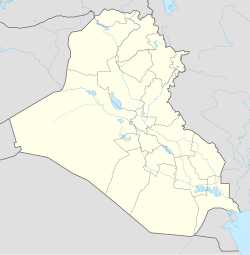Byara
Byara بیارە | |
|---|---|
Town | |
 Statue of Kurdish artist Othman Mumin Aziz in the city center of Byara | |
 | |
| Coordinates: 35°13′47″N 46°07′12″E / 35.2298°N 46.1199°E | |
| Country | |
| Region | |
| Governorate | Halabja Governorate |
| District | Byara District |
| Time zone | UTC+3 (AST) |
Byara (Kurdish: بیارە, romanized: Biyare) is a town located in the Halabja Governorate of the Kurdistan Region in Iraq. It is the main town of Byara District.[1]
Geography
Byara is located in the northeastern part of the Halabja Governorate within the Kurdistan Region of Iraq, near the Iran border. The town is situated in the mountainous Hawraman region, characterized by steep hills and valleys. This region is known for its terraced farming and agricultural production, thanks to the fertile land and the local climate, which is Mediterranean, with hot summers and cold winters. The proximity to the Iranian border has historically made Byara an important cultural and commercial hub for the Kurdish people.[2]
Historical Significance
Byara has a long history as a center of Kurdish culture and commerce. It was a key town in the historically significant Hawraman region. From 2001 to 2003, Byara was the center of the Islamic Emirate of Kurdistan, an unrecognized self-declared Kurdish Islamic state governed under Sharia law. The emirate controlled parts of the Halabja Governorate during this period. The Islamic Emirate was dissolved following the onset of the 2003 Iraq War, when a military operation led by U.S. forces and Kurdish Peshmerga forces of the Patriotic Union of Kurdistan and Kurdish Democratic Party.[3] eliminated insurgent groups in the region, marking the end of the Islamic Emirate's control.[citation needed]
Demographics
The town's population consists of Kurdish people, with a rich cultural heritage centered on the Kurdish language, customs, and traditions.[citation needed] The area is predominantly rural, with agriculture being the main economic activity.[citation needed] There is also a significant number of families involved in livestock farming due to the mountainous terrain.[citation needed]
Economy
The economy of Byara is primarily agricultural. The fertile soil, combined with the local climate, allows for the cultivation of various crops, including cereals, vegetables, and fruits. Livestock farming, particularly sheep and goats, is also a significant part of the local economy. The town has a number of small markets where locals sell their produce and goods.[4]
Notes
Byara has become a symbol of Kurdish resilience and culture in the Halabja Governorate.[citation needed] Its historical significance during the time of the Islamic Emirate, as well as its strategic location near the Iranian border, has played an important role in shaping the town's identity.[citation needed]
References
- ^ KCMS. "آشنایی با اورامانات :: فرمانداری سروآباد". Archived from the original on 2016-11-04. Retrieved 2016-11-02.
- ^ "BYARA (بیارە) – Live The Life Expeditions". Retrieved 2025-03-17.
- ^ Robinson, *Masters of Chaos*, Archived at: Chapter 13, Accessed: February 14, 2012.
- ^ Marwan, لەلایەن Sarkawt (2024-08-12). "Byara village eyes global tourism recognition amid market surge". Retrieved 2025-03-17.

